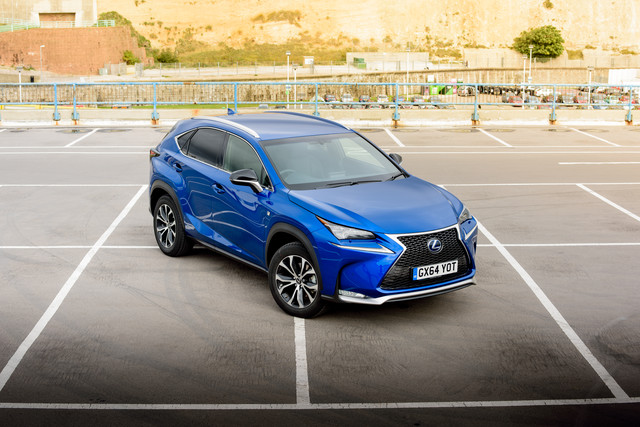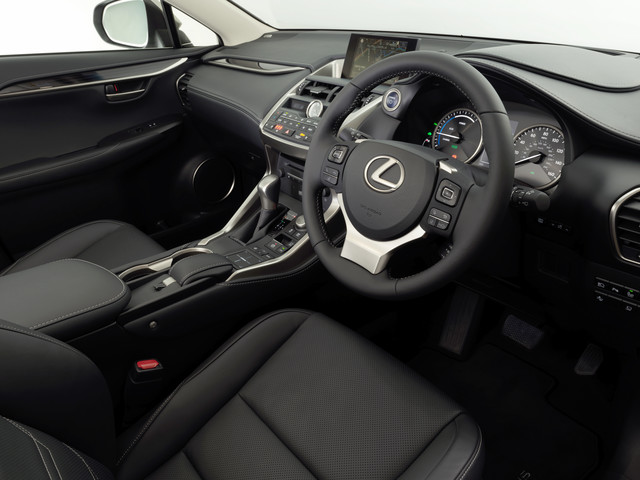When Lexus put its NX on display at the 2014 Beijing International Automotive Exhibition, the question that immediately came to the minds of some people was, "Are they really going to put it into production looking like that?" And yes, they really have. Smooth curves be damned, the Lexus NX is a thing of sharp edges, and it's not for some people.
The NX (it means "Nimble Crossover", a term we'll be returning to shortly) is a compact SUV related to the Toyota RAV4 and, although you can have one called the 200t with a 2.0-litre petrol engine, most of the versions sold in Britain are 300h hybrids which feature both a 2.5-litre engine and an electric motor whose combined output is 195bhp.
The entry-level S model has front-wheel drive, but the others, including the Luxury tested here, send the drive to all four wheels through CVT automatic transmission.
The interior is both smartly designed and very roomy, with more than enough space for a quartet of six-footers. Luggage capacity isn't bad at 475 litres, but the NX 200t (which doesn't have a battery pack to lug around) offers 500, while the shorter RAV4 has a much more impressive 647.
The petrol engine doesn't make a particularly satisfying sound, but you hear it so rarely that this hardly matters. Obviously, when the NX 300h is running in electric-only mode the engine is silent. In faster, out-of-town motoring it's still hardly audible, and can really only be heard under strong acceleration. Lexus clearly hasn't forgotten how to keep as much engine noise as possible out of the cabin.

If you want a quick NX, buy the 200t. The 300h performs in a leisurely manner, accelerating from 0-62mph in 9.2 seconds or more and maxing out at 112mph. Not exciting, but this was never meant to be an exciting car.
It should, however, be a comfortable one, and up to a point it is. Over long undulations which the suspension has plenty of time to absorb, it rides magnificently - even gloriously, which is the word that came to mind when I first experienced the effect.
But asking the springs and dampers to deal with sharper bumps is like giving a man with a broken wrist four minutes to write out the complete works of Shakespeare. There simply isn't time to do the job properly, and as a result the ride becomes very harsh, especially if another bump comes along while the car is still in a state of confusion about the first one.
The handling is affected too, but on very good surfaces it's pleasant enough, if hardly nimble as the car's name suggests it should be. "Stately" is nearer the mark.
Combined fuel economy is 56.5mpg and the CO2 emissions are rated at 121g/km. The second of these figures is rather inconvenient, since it puts it at the start of Vehicle Excise Duty Band D. Therefore, your annual tax payments will be £110 rather than £30 for the front-wheel drive S, which is also quite a lot cheaper to buy because it has less equipment.

The 56.5mpg statistic is not one that should be taken too seriously if you plan to drive on the open road very often. A large proportion of this test was conducted on motorways, and according to the trip computer I averaged just under 40mpg, while my own measurements suggested that the computer is about 3mpg overoptimistic.
Fuel economy in the high 30s is about the same as you'll get in a diesel-engined SUV of similar size, and in fact it's what I recently managed in a less powerful but lighter Ford Kuga diesel a few weeks ago.
Some readers may protest that it's a very good figure for a petrol automatic, and of course it is (the NX 200t would have trouble getting anywhere near it) but the presence of the electric motor makes that a moot point. In town, of course, the 300h will use much less fuel than a diesel rival, even one with start-stop engine technology, because of its ability to run on battery power alone.



